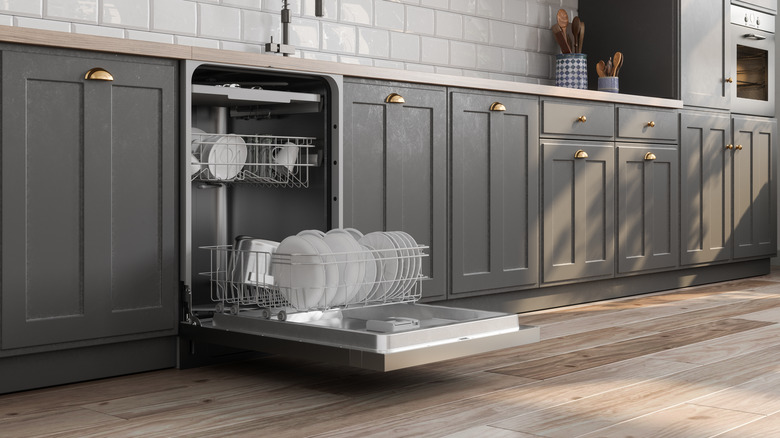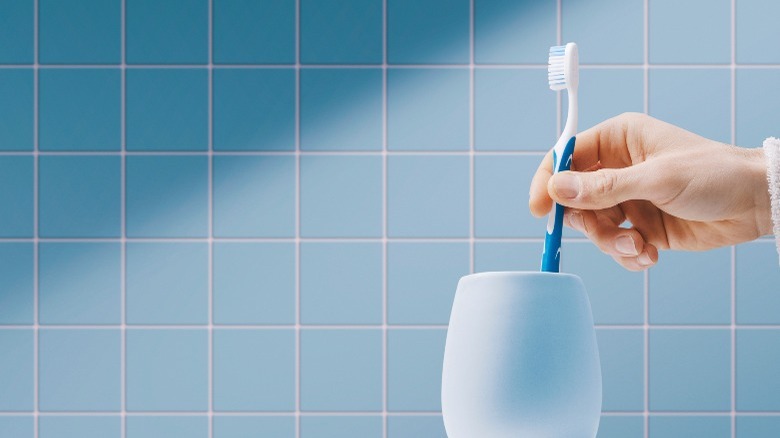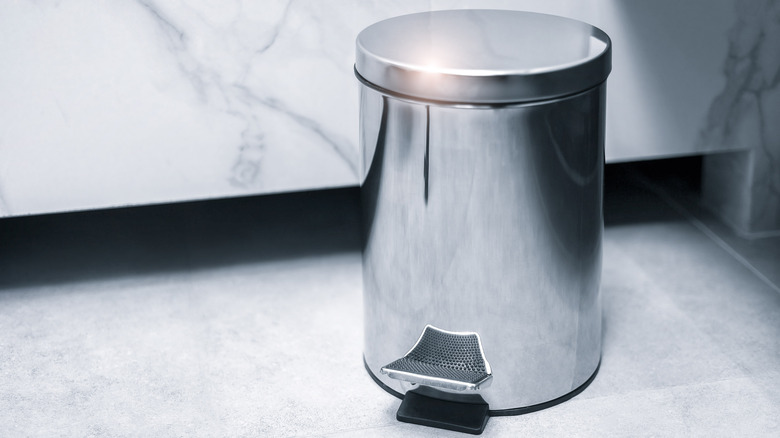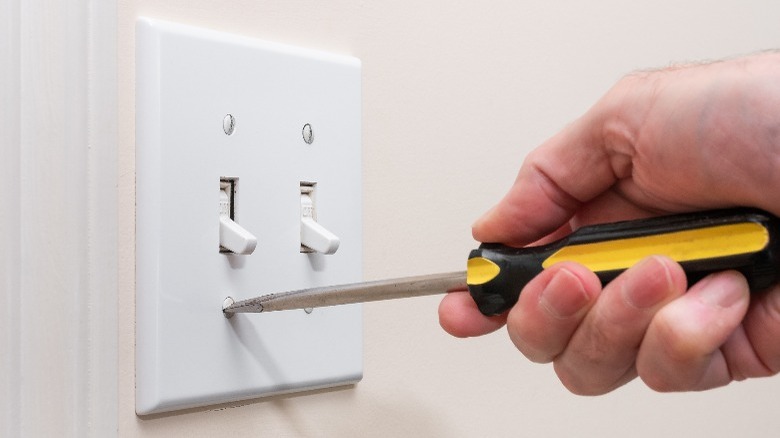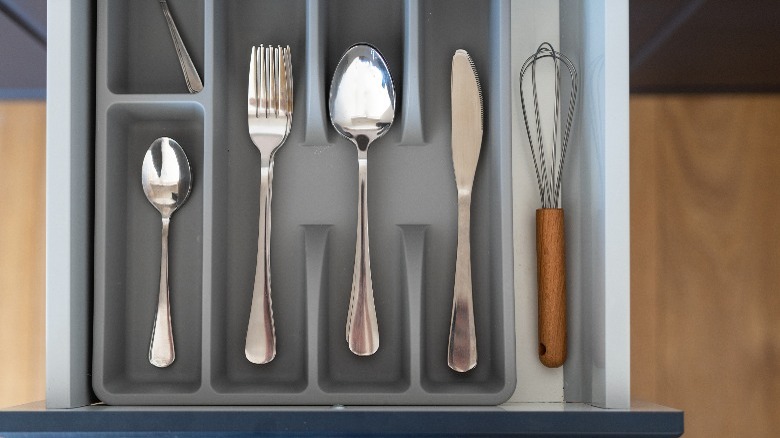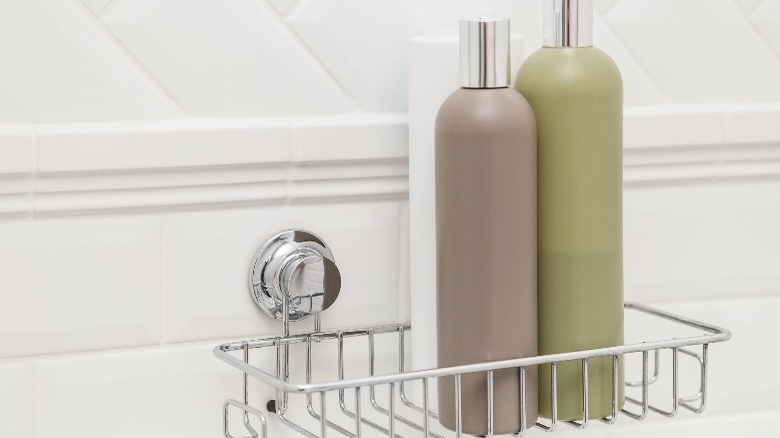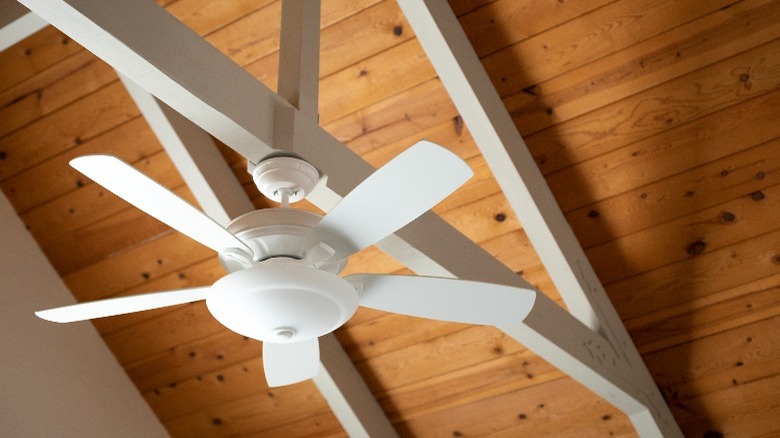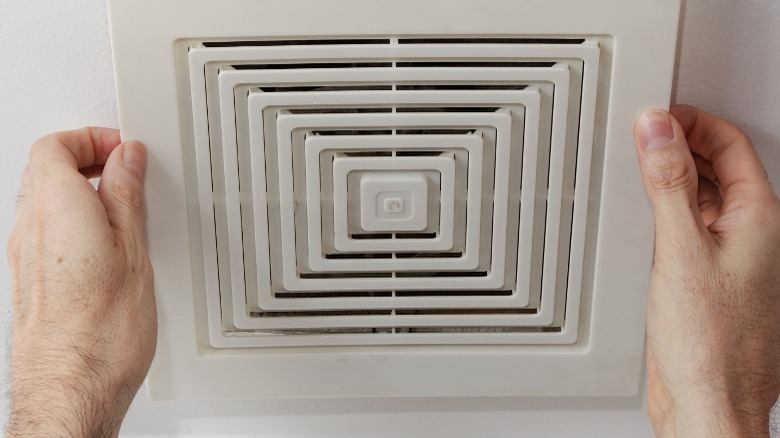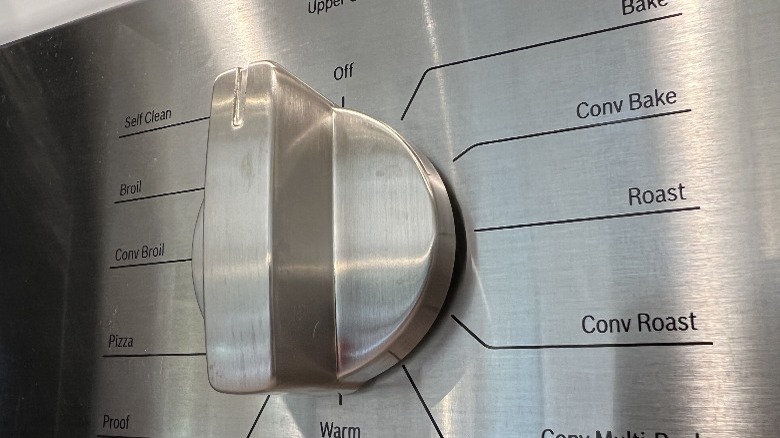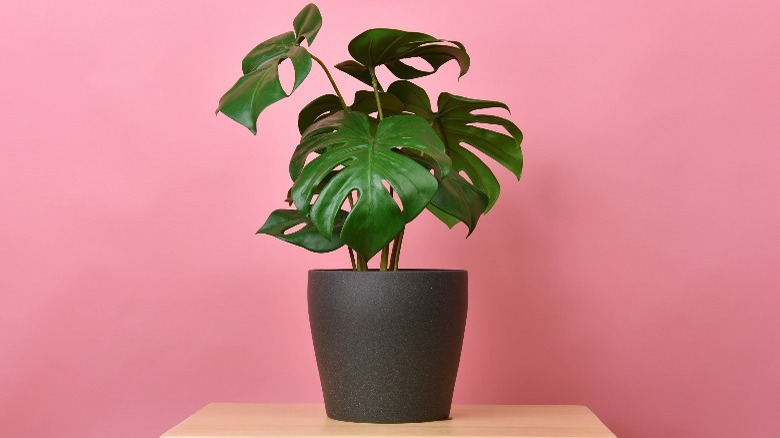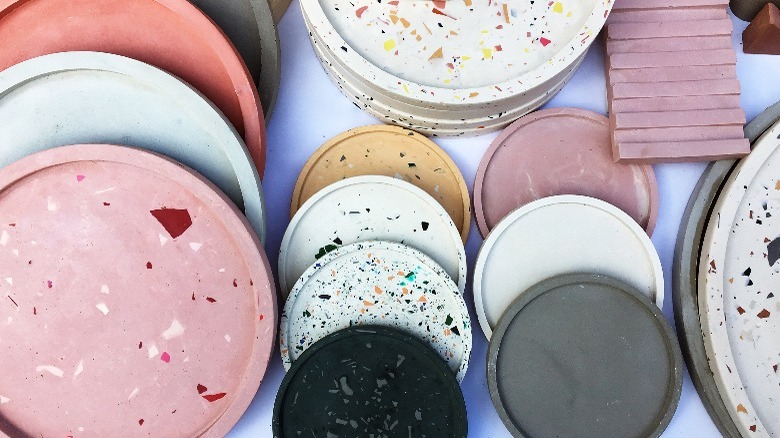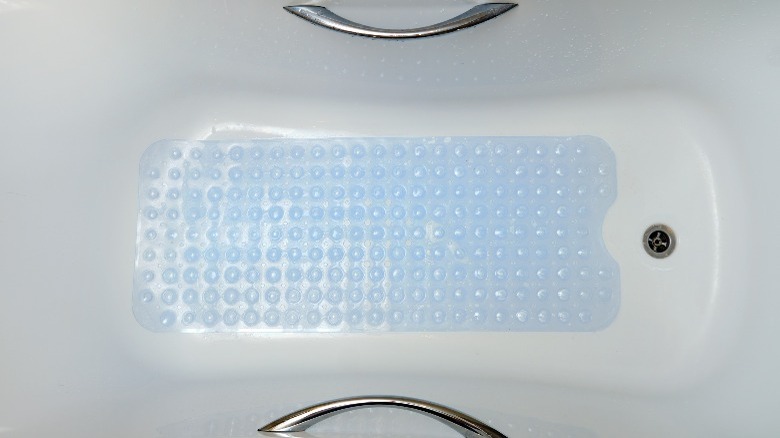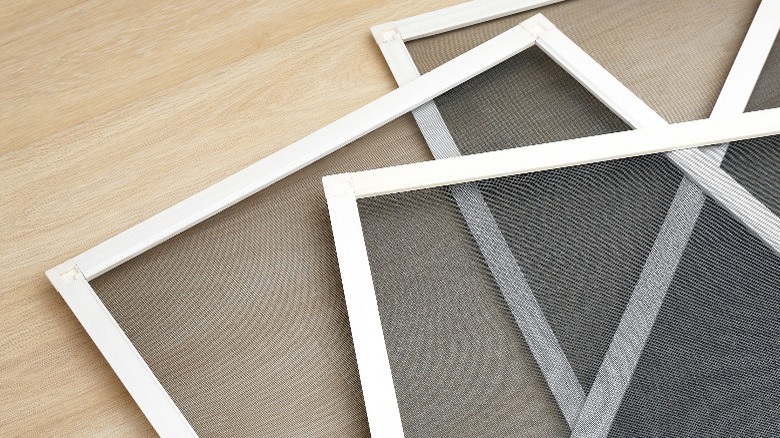Home Decor Items You Should Be Cleaning In Your Dishwasher
The dishwasher is one of the most convenient, time-saving appliances ever invented, but most people don't take advantage of all its capabilities. While it's designed to clean plates, utensils, cooking, and serving pieces, it can also clean certain home decor items. This is an easy, time-saving hack as long as the items are dishwasher-safe and small enough to fit inside.
While no industry standard describes which home decor items can be safely cleaned in dishwashers, everyday dishware, stainless steel, hard plastic, glass, metal, and silicone are generally safe. But certain things should never go in these appliances, like high-carbon steel knives, hand-painted ceramics, and anything made from wood. It's best to wash those by hand since water and heat can damage these. Dish detergent is alkaline and can cause corrosion, too. Also avoid putting antiques, thin plastic items, copper, brass, or silver items inside dishwashers.
Knowing what to avoid and where to place things makes this much easier. Since a dishwasher's heating element is usually on the bottom, stuff on that rack gets hotter, so home decor items should usually be put up top. The next step is to go through the different rooms to gather dishwasher-safe things that need a thorough cleaning. And if there's a question about whether the item will survive the wash cycle, just clean it by hand.
Toothbrush and soap holders
Toothbrushes and flossers don't get lost when they're corralled in toothbrush holders, but the water, debris, and toothpaste residue drip down and make an icky mess. That's because these tools are still wet after being used. This liquid can be poured into the sink daily, but that doesn't get the inside clean. And the longer it sits there, the greater the chance for bacteria growth. Putting it in the dishwasher once a week is smarter. And if it has a sanitizing cycle, turn it on whenever the toothbrush holder is washed. Genius move!
Soap bar holders can get pretty gross, too, because soap is also wet and drippy when it gets put back. The scum can be thicker than toothpaste residue and harder to remove. If the soap holder hasn't been cleaned off in a long time, it might need to be soaked in hot water to loosen the scum before being placed in the dishwasher.
Vases and outdoor flower pots
Small vases and flowerpots can be cleaned in dishwashers as long as they aren't too heavy, delicate, or hand-painted. Ones trimmed with gilt should be kept out. Smaller garden tools like spades that don't have wooden handles can also go in there. If they're small enough, stick them in the silverware compartment. Periodic deep cleanings will prevent rust and can also remove sap and dirt.
Before putting vases and tools in a dishwasher, rinse them inside and out with water first. Too much caked-on dirt could clog the filter, which would then need to be removed and cleaned. Use the sanitizing cycle when cleaning vases and tools because many plants develop viruses, and those can be transmitted in soil particles. Sanitizing gives plants and flowers a better chance for survival. After taking out the tools, remember to dry off any metal parts by hand to prevent corrosion.
Small trashcans
Full-sized kitchen garbage cans obviously don't fit inside dishwashers, but smaller ones just might. Some trashcans can be tucked in the bottom rack, but the top one might need to be raised. When the dishwasher doesn't have an adjustable top rack, and the wastebasket barely fits on the bottom, don't force it. Instead, wash the trashcan elsewhere. If the trashcan has a removable lid, take that off and place it in the top rack; turn the can upside down before securing it on the lower one.
Even when small trashcan liners are used, dirt and grime can still accumulate on the bottom. If left too long, the crud can harden and be impossible to remove. Try to give it a dishwasher-cleaning at least once a month to keep it tidy and smelling a whole lot better. Small bathroom trashcans can be added when the bathroom accessories are going in the dishwasher, so everything can all be done at once.
Switch plates and outlet covers
These two small items are often high-contact areas that get covered with fingerprints, grease, and grime. Adults and kids often touch these with dirty hands, and because of that, they can help spread bacteria in your house. While your instinct might be to wipe them down with cleaner, that can pose a safety risk since moisture can get underneath. The internal components can get damaged and might present a fire hazard. Spraying cleaner onto a cloth or towel is safer, but there is a better way.
Simply put the covers into the dishwasher! Turn off the electricity, unscrew or pop off the plate or cover, and put it in the dishwasher's top rack. This will not only sanitize them better than a cleaning spray, but it's also safer to do. Just make sure that they're completely dry before reattaching them to the wall.
Drawer organizers
A messy and sticky drawer organizer can dirty up everything that's put in it. These trays are must-haves for anyone who needs to locate things in drawers, but they sure amass a lot of crumbs, dirt, and debris. A buildup happens when the utensils cover up the mess beneath — it might not be seen unless everything is taken out.
The hard way to clean a drawer organizer is to soak it in a sink filled with soap and hot water. Then, the crevices would need to be cleaned with a toothbrush, kitchen sponge, or scrubber. There's no need for this extra elbow grease since the tray can be washed in a dishwasher. Simply turn it upside down and place it on the top rack; it will look like new after the cycle's complete. Just ensure you put it in the top rack so the plastic doesn't accidentally warp. Also, refrain from doing this if you have a bamboo version since the wood can splinter. Aim to do this once a month.
Shower caddies
Plastic-coated and metal shower caddies are perfect for keeping shampoo, conditioner, and soaps within easy reach, but the initial pristine appearance doesn't last long. That's because shower caddies get caked with soap scum, and thanks to their wires, they're a bit of a pain to clean.
Smaller shower caddies can be washed in dishwashers as long as they can fit. If the shelf has removable parts like suction cups, remove them first and place them somewhere that they won't get lost, like inside a bathroom drawer. Dry the caddy by hand after removing it from the dishwasher, especially if it's a metal one; otherwise, it could rust. And if the shower head is easy to disconnect, that could also be safely washed in the dishwasher. To prevent soap scum buildup on shower caddies, rinse off personal care product bottles under the shower stream before putting them back on the shelf.
Vinyl ceiling fan blades
It's easy to forget that ceiling fan blades get dirty because they're up so high and not touched often. The top parts can't even be seen unless someone climbs up there, and that's where dust gathers. When it gets really bad, the dirt can be seen on the edges and bottoms, but letting it get that nasty is never a good idea. Cleaning the blades is an important chore, especially when people in the house have allergies.
Ceiling fans are made of different materials, but only those made from plastic or vinyl are dishwasher-safe. It's a good idea to wear a dust mask when detaching them, particularly if they haven't been cleaned in ages. Run them on a short cycle on the top rack, wipe them down with a microfiber cloth, and let them air dry. Then, they can be reattached. And once the fan is used again, the air will seem much cleaner without all that dust circulating.
Exhaust fan covers
Exhaust fans are used in different parts of the home, most commonly for range hoods and bathroom ceilings. They remove smells and moisture and keep the air circulating, but they have to be protected. It's common for the covers and filters behind them to get clogged up with gunk like grease and mold, but they don't need to be cleaned by hand.
They will need to be removed first, though. Turn off the electricity and unscrew the cover or remove it according to the manufacturer's directions. Some are installed with pins on the sides; in most cases, those need to be pressed down to remove the covers. While the cover and filter are being cleaned in the dishwasher, clean the inside of the fan. A vacuum attachment is great for this, and the blades and motor can be wiped down with a damp cloth. This part is more involved, but only needs to be done about twice a year. Let the cover and filter air dry before reinstalling them.
Stove knobs
Stove knobs are some of the dirtiest parts of a kitchen. They are frequently touched and turned by fingers with food residue like grease. And when the knobs are black, it's harder to see how dirty they are. Many aren't dishwasher-safe and take a long time to remove, but some can survive and come out better for it. Avoid doing this with knobs made from brass or copper since they can become dull or tarnished. And if the knob is painted with an arrow or anything else, only clean those by hand, or the markings will likely fade.
Most stove knobs can be pulled off after being turned to the off position. Turning off the gas or electricity is unnecessary since the burners can't be activated once the appliance is off. When a knob is stuck, do not force it — just clean it by hand. Once removed, they can be placed in the utensil caddy or inside a mesh bag in the top rack. Enamel-coated burner grates are also dishwasher-safe if they are coated on all sides. They can go in the upper or lower rack.
Some artificial plants
Artificial plants and flowers add design interest to rooms, but like real houseplants, they can be notorious dust collectors. Wiping down each leaf is tedious and time-consuming, but if a plastic plant is small enough, it could benefit from a shower in the dishwasher. Do not put silk plants in there because the water and heat will ruin them.
To clean an artificial plastic plant in a dishwasher, turn it upside down in the sink first and gently shake it to loosen any dust and debris. Place it in the top rack, and set the dishwasher on gentle without adding a dry cycle. If the dishwasher doesn't have a separate one, remember to take out the plant before the drying commences. Carefully shake it over the kitchen sink while it's damp, fluff it up as needed, and let it air dry upside down in a dish rack. Voila! The plant will look new and shiny again.
Coasters and trivets
Coasters and trivets come in different shapes and sizes and are must-haves for protecting tables, counters, and other surfaces. But since they serve as barriers between food and drink serving pieces, they get dirty, crusty, and covered in bacteria. There are also the dreaded coffee, juice, or red wine rings, which can be indicators of a good time, but unsightly for the next one.
You can spruce them up by popping them into your next dishwasher cycle. In general, ones made from metal, plastic, or tile are safe. They can be lined up on the top rack or secured inside a mesh bag. Be sure to wash them all at the same time, whether they're dirty or not. This way, if there's any fading, they will still look the same afterward. Trivets and coasters made from other materials like stone or ceramic can often be cleaned with a bit of water and a drop of gentle dishwashing detergent.
Desk accessories
People who work at desks all day long are often so glad when quitting time rolls around that they head out without cleaning up. Others are just too busy to spend the time needed to clean every single accessory that is there. Paper organizers, pencil holders, and small racks can benefit from being washed in the dishwasher. If there are any small plastic drawers like the ones seen in rolling desks, those can be removed, turned upside down, and put on the top rack.
And while the accessories are getting washed, take a few minutes to dust off the less cluttered desktop and wipe down the computer screen. Now's also a good time to turn the keyboard over and shake out those food crumbs. There's a lot to be said for a clean workstation, and there's no point in putting clean accessories on a messy desktop. Now that things are in order, it's time to get to the real work.
Bathtub and car mats
Some homes do not have bathmats on the shower floors, but not having one is a safety hazard since a smooth, wet surface is easy to slip on. Some of these mats are made with drainage holes, but this doesn't stop them from getting dirty. They often get neglected and can get covered with dirt, oils, and mold. A quick shakeout now and then helps, but it's not the same as deep cleaning.
Bathmats can be made from plastic, memory foam, or rubber. Put them on the rack with the rubber part facing up — that is where most of the mold growth happens. Add the dishwasher detergent into the dispenser, and if there's a second dispenser next to it, fill it partway with vinegar. This is an effective mold remover. Run the dishwasher on a regular cycle and let the mat air dry. Car mats can also be cleaned in the same way, but shake them out well beforehand.
Light fixture globes
Anyone who's ever noticed dead bugs inside a light fixture globe will be thrilled to know that these home decor items can also survive the dishwasher. And it doesn't need to be a ceiling fixture either, since the ones on lamps can also be cleaned this way. This can only be done with ones made from plastic or glass, though.
The only caveat is that these globes aren't as thick as drinking glasses, so cleaning them on a gentle cycle is safer. To clean one, remove it from the fixture and put it face-up on the top rack. Don't place other items near it because they could bang against the more fragile surface during the cycle. If the house has hard water, add a rinse aid to prevent water spots. With that added boost, the globes should be sparkly-clean once removed. However, using the heat cycle might be tricky, especially for thinner glass and plastics. To stay on the safe side, skip that cycle and wipe the inside and outside of the globe with a microfiber cloth instead.
Window screens
Small window screens can be cleaned in dishwasher top racks, which is a lot easier than cleaning every tiny crevice by hand. For the best results, they should be hosed off first to remove dead bugs and such.
Other household screens can also be cleaned in the dishwasher. But since window screens are usually larger, the top rack might only be able to accommodate one at a time. When it's not possible to wash them this way, there's another cleaning hack that can save time, and the screens don't even need to be removed. Vacuum off the dust with a hose attachment and clean gently with a damp toothbrush or magic eraser. This is only a temporary fix because they need to be removed for a thorough cleaning. But unless there was a heavy dust storm or a spill, window screens don't need to be cleaned often.

